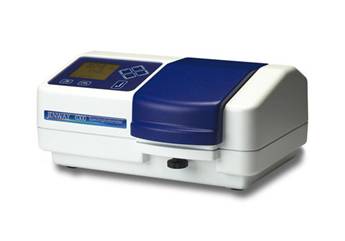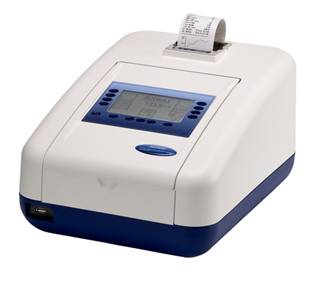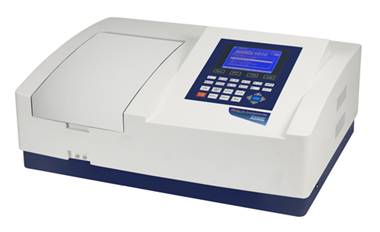A spectrophotometer is an instrument for analyzing and measuring spectra. There are different types of spectrophotometers because of the application requirements. Spectrophotometers can be divided into different wavelengths and applications:
(1) Visible spectrophotometer
(2) UV spectrophotometer
(3) Infrared spectrophotometer
(4) Fluorescence spectrophotometer
(5) Atomic absorption spectrophotometer.
The ultra-micro spectrophotometer, which is more popular in the life science field today, is one of the ultraviolet spectrophotometers.
(1) Visible spectrophotometer
An instrument for measuring the absorbance of visible light (400-760 nm) of a test substance and performing quantitative analysis is called a visible spectrophotometer. Bacterial cell density can be determined at 600 nm.

(Visible spectrophotometer diagram provided by BIBBY - Jenway, UK)
(2) UV-visible spectrophotometer
An ultraviolet-visible spectrophotometer is an instrument for measuring the absorbance of a substance to be detected by visible light or ultraviolet light (200 to 760 nm) and performing quantitative analysis. The concentration of nucleic acids and proteins can be determined, and the bacterial cell density can also be determined. The ultraviolet spectrophotometer can be further divided into a single beam, a pseudo double beam, and a double beam. Their uses are different.
a) Single beam: suitable for measuring absorbance or transmittance at a given wavelength, generally not for full-band spectral scanning, requiring high stability of the source and detector.

(British BIBBY - Ultraviolet spectrophotometer provided by Jenway)
b) Dual beam: automatic recording, fast full-band scanning. It can eliminate the influence of unstable source, detector sensitivity and other factors, especially suitable for structural analysis. The instrument is complex and the price is high.

(British BIBBY - Jenway provides a dual-beam UV spectrophotometer: 6850)
c) The pseudo-double beam is also a proportional double beam. The principle is that the light emitted by the same monochromator is split into two beams, one beam directly reaching the detector and the other beam passing through the sample and reaching the other detector. The advantage of this instrument is that it can monitor the error caused by the change of the light source, but it does not eliminate the influence of the reference.
(3) Infrared spectrophotometer
The general infrared spectrum refers to an infrared spectrum larger than 760 nm, which is the most commonly used spectral region for studying organic compounds, and can analyze samples of various states (gas, liquid, solid).
The characteristics of infrared spectroscopy are: fast, small sample volume (several micrograms - several milligrams), strong characteristic (various substances have their specific infrared spectrum), and can analyze various states (gas, liquid, solid) And do not destroy the sample.
(4) Fluorescence spectrophotometer
A fluorescence spectrophotometer is an instrument used to scan the fluorescence spectrum emitted by a liquid phase fluorescent label. Used in scientific research, chemical, pharmaceutical, biochemical, environmental protection and clinical testing, food testing, teaching experiments and other fields.
By measuring these parameters, not only can general quantitative analysis be performed, but also the conformational changes of molecules in various environments can be inferred, thereby elucidating the relationship between molecular structure and function.

(British spectrophotometer provided by BIBBY - Jenway)
(5) Atomic absorption spectrophotometer
This method is mainly used for one of the routine instruments for the analysis of trace and trace components in samples. It is a powerful tool for material analysis and quality control departments for the analysis of constant and trace metal (semi-metal) elements.
The differences between the above-mentioned common spectrophotometers are the contents of this article. I hope that everyone can better use the spectrophotometer after understanding. (The above part is transferred from the security network)
About the language and the British Bibby / Germany ART / Germany CAT:
Guangzhou Special Instrument Technology Co., Ltd. specializes in general instruments such as laboratory sample preparation such as agitator/dispersive emulsifier, analytical instruments such as melting point/photometer, and life science instruments such as PCR. As the first generation of Bibby in South China, Guangdong, Guangxi, Sichuan, Chongqing, Yunnan, Hainan, Guizhou and Tibet are our services. The company is also the German ART, the first generation of German CAT in China.
British BIBBY was founded in the 1950s as one of the UK's largest manufacturers of laboratory scientific instruments and instruments, one of the world's most extensive range of laboratory instrument manufacturers, offering high quality and high quality products to the world. Known for operational performance. It has four sub-brands: Stuart, Techne, Jenway, Electrothermal.
ï¬ Stuart: Specialized laboratory instruments such as sample pretreatment, including: colony counter, melting point meter, agitator, mixer, shaker, pure water distiller series;
ï¬ Techne: Focus on molecular biology research equipment (gene amplification equipment and hybridization boxes), as well as temperature control product lines (including water baths and dry baths);
ï¬ Jenway: an expert in analytical instruments such as UV/Spectrophotometer, Flame Photometer, and Colorimeter;
ï¬ Electrothermal: As a new member of BIBBY with more than 70 years of history, the world's leading scientific instrument provider provides electric heating sets, parallel reaction equipment, Kjeldahl nitrogen equipment, and electronic Bunsen burner series. Its parallel reaction workstation is the global market leader.
Founded in the last century, Germany ART is the most professional dispersing emulsifier in Germany and the world. Its top-grade dispersing emulsified products range from laboratory instruments to pilot products to industrial equipment. There are many types of dispersing heads to meet customers' various needs. The application fields cover chemical, cosmetic, pharmaceutical, food, environmental protection and other fields.
Founded in the 1950s, CAT Germany is one of the experts in German sample preparation instruments. Its agitator, from hand-held, teaching, to scientific research, high-viscosity type, is the representative product line of CAT; nowadays it is from ordinary electronic motor to brushless motor, product miniaturization, leading the development of agitator trend.
Another important function of amino acids is to provide energy to the human body. Normally, a healthy body on a general diet will use carbohydrates as its main fuel, but when the main source is depleted due to strenuous exercise, protein and amino acids can be used as a last resort. Amino acids also play an important role in food taste. Protein doesn't have much taste, but each amino acid has its own taste, and combining them is one of the important factors that define the taste of food
Amino Acid,Asn Amino Acid,Leucine Powder,Food Grade L-Tryptophan
YT(Xi'an) Biochem Co., Ltd. , https://www.ytherblifes.com